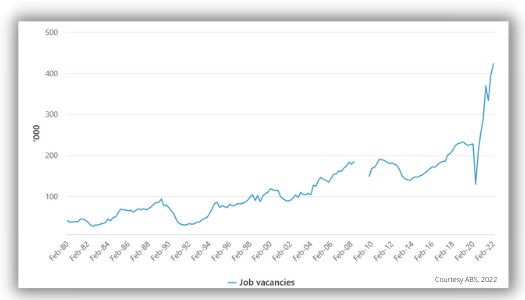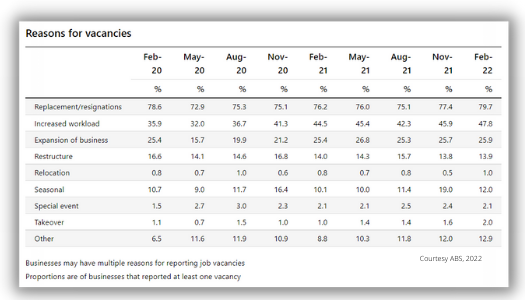
The Great 'Dividing' Resignation
by Shaun McCarthy & Melissa Jones
At the tail-end of 2021, every masthead in the region (and the world for that matter) sprouted dire forewarnings of resignations en masse. Opinions were divided; fact, fantasy, phase? Every CEO and HR Director from here to Timbukto was suddenly faced
with the scenario of workers with historically lengthy tenures, giving way to the marauding adversaries baiting them on job boards around the country. Suddenly the ensuing talent shortage meant that we were shifting to an employee's market? So what
would this mean for companies left with workforce shortfalls and what was the action plan for attracting talent left by departing workers?
Despite the term 'Great Resignation' being batted around early on in the piece, the term seemed prevalent in conversation only, (initially at least) as the ABS reported late last year only slight rises in the number of people jumping ship.
By contrast, we saw in both the US and the UK a significantly higher rate of resignations during 2021 that continue to be felt today. As elevating numbers are flagged here, perhaps the biggest influence in our part of the world might be the expectation
of an even greater resignation? So how do CEOs and HR directors mitigate the damage from the fallout? Perhaps the truth lies in being active rather than re-active?

The Australian Bureau of Statistics has advised that job vacancies (see above) have increased by 6.9% in the 3 months to February 2022 (post Omicron peak) and the
level of job vacancies in February 2022 was 86% higher than in February 2020, prior to the start of the pandemic (1).
So what was driving the great resignation? Why were people leaving their positions halfway through the most tumultuous
period of global economic change and an ever-mutating pandemic? What is hidden in the ABS macro-diagram below (released 31/3/22) requires a deeper delve of the driving factors behind people leaving their jobs.

In a recent article (2) from MIT Sloan, the five leading causes contributing to the global movement included; a toxic corporate culture, job insecurity, high levels of innovation, failure
to recognise performance and a poor response to COVID-19 ... and yes, in that order.
The report focused internally on the US sector, but many would agree that the same summation ultimately strikes a chord here. In a similar report, toxic culture was identified as the single most deciding factor of attrition during the first
six months of the Great Resignation, viewed 10 times more powerful than how employees viewed their compensation in predicting employee turnover (3). The link between a toxic organisational culture and staff resignations is then very clear.
So how do we retain our staff? Realistically a great organisation can be compared to a grand, majestic galley ship of old. Built by sturdy material, designed with to withstand any scenario, captained by a knowledgable skipper, operated by rowers working
in a high functioning unit with one aim - to sail, to sail well and to sail safe!
The metaphor of the galley ship is a great one to describe how performance can be achieved through sound, sustainable and demonstrable organisational culture, underpinned by great leadership that drives high performing teams made up of individuals encouraged
to reach their potential.
So do you know where your employees are at in the galley ship? Are they fulfilled, recognised and rewarded for the integral role they play? Are they often included on conversations about the team goals and performance? Or are they approaching the stern
ready to jump ship?
Of course there are a myriad of reasons any given employee may move on, but generally employees are more likely to exit organisations that fail to distinguish between high performers and under-achievers whom are merely tolerated when it comes to recognition
and rewards. High-performing and self-actualising employees are the most likely to resent a lack of recognition for their results, which means that companies may be losing some of their most productive workers during this 'great resignation'.
So what are some short term steps to retain staff? Firstly start designing your galley ship for building a constructive culture:
- Concentrate on building a sense of shared purpose amongst your people through focusing on articulation of mission and customer service focus. A statement that encompasses:
- Why do you exist as an organisation?
- What societal function does your organisation fulfill?
- What particular need in society does you product/service fulfill?
- Who does your organisation exist to serve?
- What is your organisation’s core mission?
- What is your vision for the organisation (in non-financial terms)?
- The key then is living this purpose, not just saying it.
- If you don’t already have one, develop an EMPLOYEE VALUE PROPOSITION (EVP). A proposition that encompasses:
- What does working for you organisation offer it’s people?
- What can people expect from being part of your organisation?
- How will people benefit from being part of your organisation?
- What do you want people to experience as part of their time with your organisation?
- Between joining and leaving your organisation, how will people grow as part of that experience?
- It doesn’t have to be complicated. In the early days of their very successful culture change program, Lion Corp simply built a model that said: “Great jobs, great mangers and great brands”. Says it all!
- As above, the key then is living this purpose, not just saying it.
Both of these, if done well will help build a more Constructive Culture throughout the organisation.
Eager to learn more about how you can create Constructive Culture? Contact us here.
With thanks to:
References
1. The Australian Bureau of Statistics, (Mar, 2022). Job Vacancies Australia, https://www.abs.gov.au/statistics/labour/jobs/job-vacancies-australia/feb-2022.
2. Sull.D, Sull.C and Zweig.B, (Jan, 2022). MIT Sloan Management Review, Toxic Culture is Driving the Great Resignation, https://sloanreview.mit.edu/article/toxic-culture-is-driving-the-great-resignation/,
3. Sull.D, Sull.C and Cipolli. W and Brighenti, C, (Mar, 2022). MIT Sloan Management Review, Why every Leader needs to worry about toxic Culture, https://sloanreview.mit.edu/article/why-every-leader-needs-to-worry-about-toxic-culture/